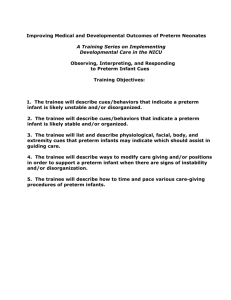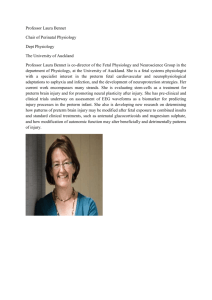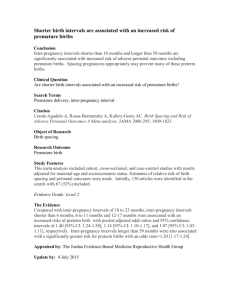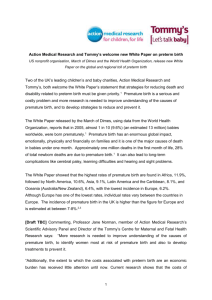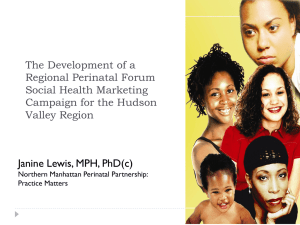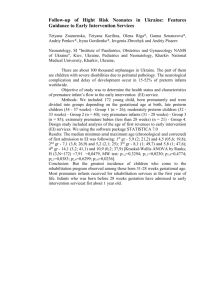March of Dimes
advertisement
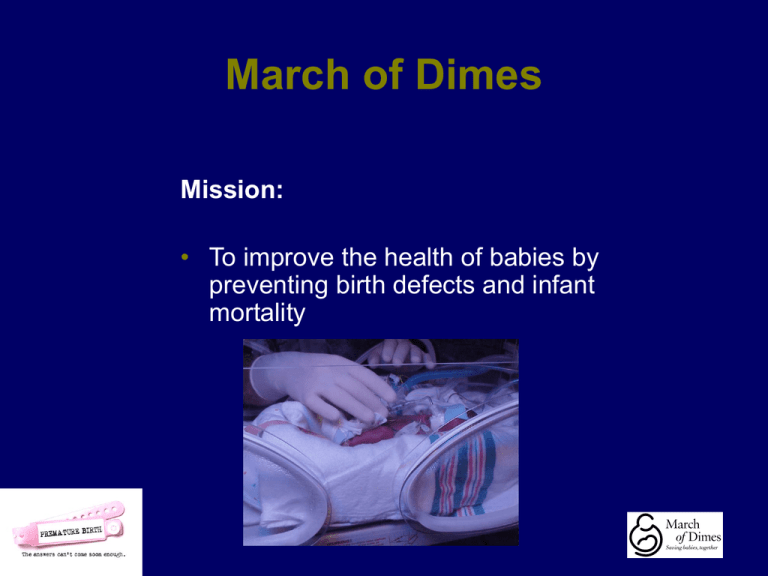
March of Dimes Mission: • To improve the health of babies by preventing birth defects and infant mortality March of Dimes Prematurity Campaign A five-year, $75 million research, awareness and education campaign to help families have healthier babies. Campaign Goals 1. Increase public awareness of the problems of prematurity to a least 60% by 2007 2. Decrease the rate of preterm birth in the U.S. by at least 15%. From 11.9% (2001 data) to < 9.9 From 476,250 preterm babies (2001) to < 405,000 Five Aims of Prematurity Campaign 1. Raise public awareness 2. Educate pregnant women and parents 3. Assist health practitioners to improve premature birth risk detection and address riskassociated factors. 4. Invest in research 5. Increase access to Care Why Prematurity? • Common, serious, costly medical burden • Major risk factor for child illness & disability • Nearly 50% of all premature Births have no known cause. • Second highest cause of infant death • Rates increasing steadily over last 3 decades Premature Birth • Premature always means too early • Premature often means too small Current Definitions • Birthweight – Low birthweight: < 2500 grams or 5.5 lbs – Very low birthweight: <1500 grams or 3.3 lbs. • Gestational age – Preterm: <37 completed weeks of pregnancy (premature) – Very preterm: <32 completed weeks of pregnancy (very premature) Major Risks for Prematurity • Obstetric Previous preterm birth Multiples (twins, triplets) Uterine and cervical infection • Medical • Behaviors cigarette smoking, alcohol use, illicit drugs use during pregnancy Diabetes, High Blood Pressure, Clotting disorder, infections, Obesity, severe stress, chronic health problems in the mother Prematurity Generates Substantial Health Care Costs • Maternity & related expenses: Often the largest cost to employers’ health care plans • In 2001, hospital charges for 26,000 infant stays that were diagnosed with prematurity/low birthweight totaled $1.9 billion, which average to $75,000.00 per stay compared to $1,300.00 for Uncomplicated new born stay. ¹Agency for Health Care Research and Quality, 2000 Primary Target Audiences • General Public • Pregnant Women • Health Care Providers Awareness Messages for the General Public • Prematurity is a serious and common problem • Only half the cases of preterm births have known cause(s) • Research holds the promise for prevention of preterm births • The March of Dimes is committed to finding the answers Parent Education Educate pregnant women on signs and symptoms of preterm labor Support parents in NICU with educational materials Fund community programs focused on reducing risk factors for prematurity Professional Education • Work in partnership with ACOG, AAP and AWHONN • Collaborate with Health Professional • Comprehensive risk detection and reduction • Signs and symptoms of premature labor •Provide professional education to doctors and nurses • Advocate for programs to improve prematurity risk detection Research • Increase March of Dimes research funding • Advocate to increase research funding for prematurity and related conditions Access • Support expanded access to health insurance to improve pregnancy outcome. What it Takes For Success: • Multiyear commitment • Partners and alliances • Concurrent activities addressing all three target audiences • Incorporating the messages into everything we do • YOU How You Can Help • Recruit Volunteer • Participate in a fund-raising/chapter event • Donate • Spread the word because…………. Premature Birth: The answers can’t come soon enough Summary of 2002 Preterm Birth Data from the National Center for Health Statistics March of Dimes Perinatal Data Center January 2004 Overview • In 2002: – 4,021,726 live births Preterm Births (<37 completed weeks) – 480,812 preterm births – 12.1% of live births Very Preterm Births (<32 completed weeks) – 77,845 very preterm births – 2.0% of live births Preterm and Very Preterm Births United States, 1992-2002 Percent of live births 14 11.4 11.6 11.8 11.6 11.9 12.1 11.0 11.0 11.0 11.0 12 10.7 10 8 6 4 2 0 1992 1994 1996 1998 2000 2002 Very Preterm Preterm is less than 37 completed weeks gestation. Very preterm is less than 32 completed weeks gestation. Source: National Center for Health Statistics, final natality data Prepared by March of Dimes Perinatal Data Center, 2004 Preterm 10.1 7.6 MOD 2007 Preterm Births By Maternal Race/Ethnicity, U.S., 2001 & 2002 Percent of live births 20 17.6 17.7 15 10.8 11.0 11.4 11.6 11.9 12.1 Hispanic All Races 10 5 0 Non-Hispanic White Non-Hispanic Black 2001 2002 Preterm is less than 37 completed weeks gestation. People of Hispanic ethnicity may be of any race. Source: National Center for Health Statistics, 2001 & 2002 final natality data Prepared by March of Dimes Perinatal Data Center, 2004 Preterm Birth Rates by State United States, 2002 U.S Rate = 12.1% Percent of Live Births Note: Value in ( ) = number of states (includes District of Columbia) Value ranges are based on equal counts Source: National Center for Health Statistics, 2002 final natality data Prepared by March of Dimes Perinatal Data Center, December 2003 Over 12.6 (17) 11.4 to 12.6 (16) Under 11.4 (18) Change in Preterm Birth Rates by State United States, 1992 to 2002 Percent Change from 1992 to 2002 Note: Value in ( ) = number of states (includes District of Columbia) Value ranges are based on equal counts Percent change has been rounded to the nearest whole number. Source: National Center for Health Statistics, 2002 final natality data Prepared by March of Dimes Perinatal Data Center, December 2003 Increased 22 to 38% (15) Increased 14 to 21% (16) Increased 1 to 13% (19) Declined (1) Change in U.S Rate = 13% Summary • In 2002: – The number and rate of preterm births in the United States continued to increase. – While the non-Hispanic black preterm birth rate was nearly twice the non-Hispanic white rate, increases occurred among nonHispanic whites and Hispanics. – Preterm birth rates and the percentage change over the past decade vary widely by state.


